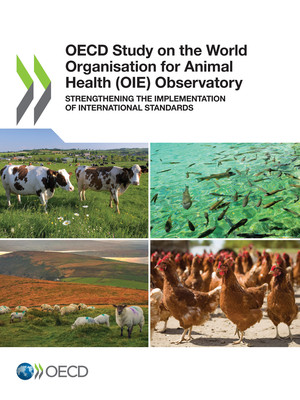copy the linklink copied!Executive summary
This study provides a diagnostic of the existing normative work, related governance structure and information collection mechanisms of the World Organisation for Animal Health (OIE) and provides recommendations to support the OIE in establishing an Observatory on the Implementation of Standards.
The OIE is the intergovernmental organisation responsible for animal health worldwide. It develops a corpus of different voluntary normative instruments, commonly referred to as OIE international standards, which aim to ensure transparency around animal health status, build good governance of veterinary services and support safe trade of animals and animal products. These OIE standards – and particularly the Codes and Manuals that are the core normative instruments of the OIE – are recognised as the reference standards in the areas of animal health, animal welfare and zoonoses, putting the organisation in a good position to identify and monitor their impacts. Domestically, veterinary authorities recognise the usefulness of OIE standards in developing national measures for improving animal health, animal welfare and international trade, and confirm consulting the OIE Codes and Manuals regularly in this regard. OIE Codes and Manuals are developed following a largely expert-driven and participatory standard-setting procedure, resulting in cutting-edge reference standards.
Despite their recognised usefulness by OIE Members, evidence on the actual uptake of OIE standards in domestic legislation remains scarce. This does not necessarily mean these standards are not used; indeed, OIE Members confirm a strong demand for them. Rather, it reflects an uneven process for the domestic application of OIE standards and inconsistent monitoring of their use. Given the voluntary nature of OIE standards, the implementation process is neither defined nor prescribed by the OIE. Members have much leeway in considering, referencing and using OIE standards. This results in varied approaches across OIE Members, making it difficult to measure the consistency of national measures with OIE standards.
This study identifies 13 data collection mechanisms at international or regional level that are used, or may be used, to gather information on the implementation of OIE standards in domestic jurisdictions. While most of these mechanisms are set up by the OIE itself, others exist in the context of the WTO, or of the European Union for example. Initially, these mechanisms were developed to address specific needs, such as providing transparency on disease status, evaluating the quality and building domestic capacity of veterinary services, or monitoring the effects of domestic regulations on international trade. As a result, they are focussed primarily on fulfilling these specific needs rather than gathering systematic evidence on the implementation of OIE standards. The information obtained through these processes is therefore limited in scope and irregular in frequency, and does not necessarily assess the link with the use of OIE individual standards.
Overall, a disconnect remains between the process of implementation by OIE Members and the standard-setting process at the OIE level, as is often the case across international organisations. The views of Members on the uses made of OIE standards are not systematically gathered and shared with the OIE Secretariat or other Members. Better information on implementation could be used to improve new or revised standards developed by the OIE and ensure their continued relevance over time for veterinary authorities across OIE Members. The information would also help to better prioritise and target capacity-building activities and refine the understanding of good practices in the implementation of OIE standards. This report identifies opportunities for gathering such information in a more systematic manner, and supports the establishment by the OIE of an Observatory on the implementation of its standards.
The OIE Observatory is an ambitious project largely unprecedented among IOs. Based on the diagnostic of the current state of play in the OIE, the OECD study provides recommendations related to the objectives of the Observatory, the definition of its scope, and its operational modalities as described below. These build on the broad range of relevant IO experiences as reflected in the IO Partnership, and have been tailored to the OIE standards and governance structure.
copy the linklink copied!Key recommendations
Setting the objectives of the Observatory
Given the nature of OIE standards and existing data collection mechanisms, the Observatory should focus on two complementary objectives:
Identifying Members’ capacity development needs and successful practices in implementing OIE standards
Enhancing the standard-setting process through evidence-based assessment of the actual use of OIE standards.
Defining the scope of the Observatory
Continue to map the OIE standards that are already the object of data collection. This involves identifying the following aspects of the existing collection mechanisms: the connection with the underlying OIE standards; the geographic coverage; the frequency of the collected information; the nature of information; the level of availability of the information and the level of the validation of the information.
Start by focusing on the implementation of OIE standards (mostly from the Terrestrial and Aquatic Codes) that already benefit from data coverage.
As the Observatory consolidates its working methods, data collection and analytical capacity, and establishes its credibility, gradually expand the scope of OIE standards included.
Continue analysing Members’ practices in implementing OIE standards and their contribution to achieving the organisation’s objectives.
Systematise, standardise and expand existing sources of information.
Co-operate with FAO, WTO, EU to make better use of their data and cross check information collected by the OIE.
Deciding the operational modalities
Define the key outputs of the Observatory, including the level and detail of information, its availability in a user-friendly database and in analytical reports.
Endow the Observatory with adequate resources.
Locate the Observatory strategically to ensure that it delivers on its key objectives – by benefitting from strong connection with the information sources and the standard-setting process, as well as autonomy to carry out relevant analysis.
Highlight transparency as a key underlying principle of the Observatory’s activities.
Establish mechanisms to benefit from stakeholder inputs and contributions, including academia, other international organisations, experts and civil society.
Define the role of Members.


